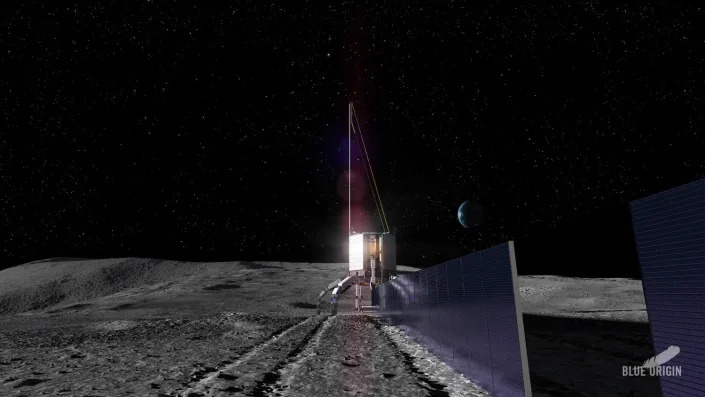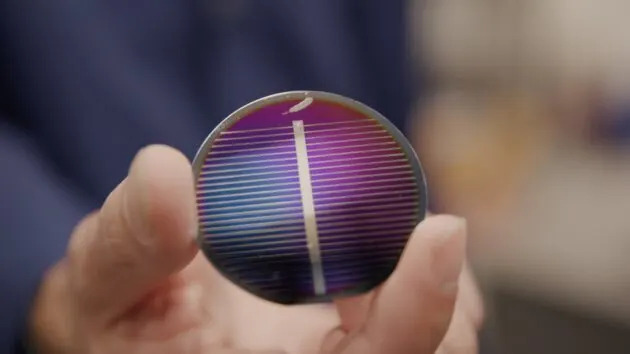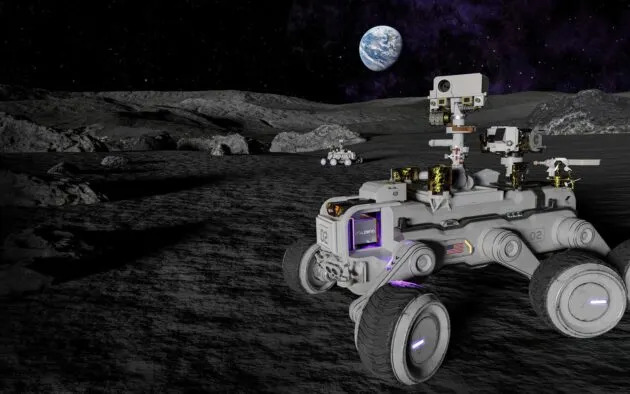
Image Credits: Blue Origin
Aria Alamalhodaei
Tue, July 25, 2023
NASA awarded new funding to 11 companies today for advanced space tech projects ranging from advanced power generation on the lunar surface to additive manufacturing for space habitats.
The awards, which total $150 million across all 11 companies, were announced as part of the space agency’s Tipping Point program. According to NASA, a technology is a “tipping point” if an investment in a demonstration would significantly mature the technology and bring it to market, for both future NASA missions and commercial customers.
In a statement, Prasun Desai, acting associate administrator for NASA’s Space Technology Mission Directorate, said that the awards are meant “to push crucial technologies over the finish line.”
“Our partnerships with industry could be a cornerstone of humanity's return to the Moon under Artemis,” he said.
Five of the 11 awards are for technologies to support long-term exploration of the moon. Those include a $34.7 million award to Blue Origin to continue advancing its solution to process solar cells from lunar regolith, a process the company says “would bootstrap unlimited electricity and power transmission cables anywhere on the surface of the Moon.” The project is part of Blue Origin’s Blue Alchemist initiative it unveiled earlier this year.
Astrobotic, a company that hopes to send a lander to the moon in the fourth quarter of this year, was awarded $34.6 million to demonstrate a new power and transmission system on the lunar surface. The LunaGrid-Lite demonstration will aim to generate solar power and transmit it across a one-kilometer-long power cable on the moon.
“LunaGrid-Lite will pave the way for power generation and distribution services on the Moon, and change the game for lunar surface systems like landers, rovers, habitats, science suits, and in-situ resource utilization pilot plants,” Astrobotic CEO John Thornton said in a statement. “With renewable, uninterrupted commercial power service, both crewed and robotic operations can be made sustainable for long-term operations.”
The other six projects to have received Tipping Point awards are focused on other areas of space technology. Those include a $1.9 million project from in-space manufacturing startup Varda Space Industries to mature and commercialize an advanced thermal protection system material first developed by NASA. United Launch Alliance was awarded $25 million to continue development of an inflatable heat shield technology, which could possibly be used to return portions of a rocket booster from space.
This is the agency’s sixth Tipping Point award cycle. The full list of awardees and NASA’s total contribution to each project can be found here.
NASA gives Blue Origin $34.7M to work on technology for making solar cells on moon
Alan Boyle
Alan Boyle
GeekWire:
Tue, July 25, 2023

The Blue Alchemist project aims to produce solar cells from lunar materials.
Tue, July 25, 2023

The Blue Alchemist project aims to produce solar cells from lunar materials.
(Blue Origin Photo)
Jeff Bezos’ Blue Origin space venture has won $34.7 million in funding from NASA to support the development of a system that could produce solar cells on the moon from materials that are available on site.
The Blue Alchemist project is one of 11 proposals winning support from the space agency’s Tipping Point program, which partners with commercial ventures to back technologies that could contribute to long-term space exploration.
“Harnessing the vast resources in space to benefit Earth is part of our mission, and we’re inspired and humbled to receive this investment from NASA to advance our innovation,” Pat Remias, vice president for Blue Origin’s Capabilities Directorate, Space Systems Development, said today in a news release. “First we return humans to the moon, then we start to ‘live off the land.’”
Blue Alchemist would use lunar regolith — the dust and crushed rock that covers the moon’s surface — as the raw material for solar cells and electrical transmission wire. Oxygen, iron, silicon and aluminum would be extracted through a process known as molten regolith electrolysis, and fed into the manufacturing process. The oxygen could be used for life support or for rocket propulsion.
Kent, Wash.-based Blue Origin has been working on the technology over the past couple of years, with Earth-produced simulants taking the place of lunar regolith.
Blue Origin is also on the team for another Tipping Point project, led by Washington, D.C.-based Zeno Power Systems. Zeno was awarded $15 million for Project Harmonia, which aims to create a new type of radioisotope power supply for the Artemis moon program that uses americium-241 as fuel.

An artist’s conception shows Zeno Power Systems’ radioisotope power supply as a purple-tinged box in a cutaway view of a lunar rover.
Jeff Bezos’ Blue Origin space venture has won $34.7 million in funding from NASA to support the development of a system that could produce solar cells on the moon from materials that are available on site.
The Blue Alchemist project is one of 11 proposals winning support from the space agency’s Tipping Point program, which partners with commercial ventures to back technologies that could contribute to long-term space exploration.
“Harnessing the vast resources in space to benefit Earth is part of our mission, and we’re inspired and humbled to receive this investment from NASA to advance our innovation,” Pat Remias, vice president for Blue Origin’s Capabilities Directorate, Space Systems Development, said today in a news release. “First we return humans to the moon, then we start to ‘live off the land.’”
Blue Alchemist would use lunar regolith — the dust and crushed rock that covers the moon’s surface — as the raw material for solar cells and electrical transmission wire. Oxygen, iron, silicon and aluminum would be extracted through a process known as molten regolith electrolysis, and fed into the manufacturing process. The oxygen could be used for life support or for rocket propulsion.
Kent, Wash.-based Blue Origin has been working on the technology over the past couple of years, with Earth-produced simulants taking the place of lunar regolith.
Blue Origin is also on the team for another Tipping Point project, led by Washington, D.C.-based Zeno Power Systems. Zeno was awarded $15 million for Project Harmonia, which aims to create a new type of radioisotope power supply for the Artemis moon program that uses americium-241 as fuel.

An artist’s conception shows Zeno Power Systems’ radioisotope power supply as a purple-tinged box in a cutaway view of a lunar rover.
(Zeno Power Systems Illustration)
Other partners on Project Harmonia include Intuitive Machines, NASA Glenn Research Center, NASA Marshall Flight Center, Sunpower and the University of Dayton Research Institute. Zeno plans to have its technology ready for a lunar surface demonstration in 2027. Theoretically, the team’s Stirling generators could provide continuous power to lunar bases for years, using radioactive material that’s currently classified as nuclear waste.
“Project Harmonia will provide the technology to transform the moon from a location darkened by night and shadow to one enlightened by science and exploration, ultimately for the good of the nation and humankind,” Tyler Bernstein, CEO and co-founder of Zeno Power, said in a news release.
This is NASA’s sixth round of Tipping Point grants. Each company receiving a grant is expected to cover a minimum percentage of the total project cost — at least 10% to 25%, based on company size. NASA’s investment in this newest round is expected to amount to $150 million over the course of a period lasting up to four years.
“Partnering with the commercial space industry lets us at NASA harness the strength of American innovation and ingenuity,” NASA Administrator Bill Nelson said in a news release. “The technologies that NASA is investing in today have the potential to be the foundation of future exploration.”
In addition to Blue Origin and Zeno Power, the newly announced Tipping Point awardees include:
Astrobotic Technology of Pittsburgh, $34.6 million – Astrobotic will demonstrate the robotic deployment of one kilometer of cable, and power transmission through that cable across the lunar surface. A CubeRover delivered by Astrobotic’s Griffin lander will deploy the power line. The demonstration will advance power generation and distribution technologies, including a high-voltage power converter and cable, plus a cable reel system.
Big Metal Additive of Denver, $5.4 million – The company will advance materials, manufacturing processes, equipment and facilities for metal hybrid additive manufacturing. The project aims to increase technology readiness and reduce lead time, material waste and cost to enable a range of structural products, including space habitats.
Freedom Photonics of Santa Barbara, California, $1.6 million – Freedom Photonics will develop a new tyupe of direct diode laser source that could enable more efficient lidar systems. The system could better detect methane in Earth’s atmosphere and improve scientists’ understanding of climate change.
Lockheed Martin of Littleton, Colorado, $9.1 million – The company will demonstrate in-space component joining and inspection technologies for structural, electrical and fluid systems. The capability would reduce risk and advance the maturity and reliability of in-space assembly architectures.
Redwire of Jacksonville, Florida, $12.9 million – The company will develop a grader, compactor and microwave emitter into a scalable platform that removes rocks, compacts loose regolith, and melts or sinters regolith into a solid surface. This technology could enable dust mitigation areas, habitat foundations, roads and landing pads.
Protoinnovations of Pittsburgh, $6.2 million – Protoinnovations will advance modular, flight-ready mobility control software for lunar rovers and robots
Psionic of Hampton, Virginia, $3.2 million – Partnering with Draper Laboratory, Psionic will conduct a flight demonstration of its Navigation Doppler Lidar and terrain contour matching system. Crewed and robotic missions could utilize the high-precision navigation system to land at various planetary destinations, including the moon.
United Launch Alliance of Centennial, Colorado, $25 million – The company will continue to evolve a proven Hypersonic Inflatable Aerodynamic Decelerator (HIAD) technology design. ULA will develop a larger 10-meter HIAD that leverages a two-piece structure to enable effective load distribution for even larger inflatable decelerators.
Varda Space Industries of El Segundo, California, $1.9 million – Varda will mature Conformal Phenolic Impregnated Carbon Ablator (C-PICA), a cost-effective and mass-efficient thermal protection system material developed by NASA. The project will put C-PICA through a flight test and start commercial production of the material.
Blue Origin talks up technology that could eventually turn moon dirt into solar cells
Blue Origin wins an order from NASA for launch of Mars magnetosphere mission
Orbital Reef space station wins a key role in Hollywood movie even before it’s built
Other partners on Project Harmonia include Intuitive Machines, NASA Glenn Research Center, NASA Marshall Flight Center, Sunpower and the University of Dayton Research Institute. Zeno plans to have its technology ready for a lunar surface demonstration in 2027. Theoretically, the team’s Stirling generators could provide continuous power to lunar bases for years, using radioactive material that’s currently classified as nuclear waste.
“Project Harmonia will provide the technology to transform the moon from a location darkened by night and shadow to one enlightened by science and exploration, ultimately for the good of the nation and humankind,” Tyler Bernstein, CEO and co-founder of Zeno Power, said in a news release.
This is NASA’s sixth round of Tipping Point grants. Each company receiving a grant is expected to cover a minimum percentage of the total project cost — at least 10% to 25%, based on company size. NASA’s investment in this newest round is expected to amount to $150 million over the course of a period lasting up to four years.
“Partnering with the commercial space industry lets us at NASA harness the strength of American innovation and ingenuity,” NASA Administrator Bill Nelson said in a news release. “The technologies that NASA is investing in today have the potential to be the foundation of future exploration.”
In addition to Blue Origin and Zeno Power, the newly announced Tipping Point awardees include:
Astrobotic Technology of Pittsburgh, $34.6 million – Astrobotic will demonstrate the robotic deployment of one kilometer of cable, and power transmission through that cable across the lunar surface. A CubeRover delivered by Astrobotic’s Griffin lander will deploy the power line. The demonstration will advance power generation and distribution technologies, including a high-voltage power converter and cable, plus a cable reel system.
Big Metal Additive of Denver, $5.4 million – The company will advance materials, manufacturing processes, equipment and facilities for metal hybrid additive manufacturing. The project aims to increase technology readiness and reduce lead time, material waste and cost to enable a range of structural products, including space habitats.
Freedom Photonics of Santa Barbara, California, $1.6 million – Freedom Photonics will develop a new tyupe of direct diode laser source that could enable more efficient lidar systems. The system could better detect methane in Earth’s atmosphere and improve scientists’ understanding of climate change.
Lockheed Martin of Littleton, Colorado, $9.1 million – The company will demonstrate in-space component joining and inspection technologies for structural, electrical and fluid systems. The capability would reduce risk and advance the maturity and reliability of in-space assembly architectures.
Redwire of Jacksonville, Florida, $12.9 million – The company will develop a grader, compactor and microwave emitter into a scalable platform that removes rocks, compacts loose regolith, and melts or sinters regolith into a solid surface. This technology could enable dust mitigation areas, habitat foundations, roads and landing pads.
Protoinnovations of Pittsburgh, $6.2 million – Protoinnovations will advance modular, flight-ready mobility control software for lunar rovers and robots
Psionic of Hampton, Virginia, $3.2 million – Partnering with Draper Laboratory, Psionic will conduct a flight demonstration of its Navigation Doppler Lidar and terrain contour matching system. Crewed and robotic missions could utilize the high-precision navigation system to land at various planetary destinations, including the moon.
United Launch Alliance of Centennial, Colorado, $25 million – The company will continue to evolve a proven Hypersonic Inflatable Aerodynamic Decelerator (HIAD) technology design. ULA will develop a larger 10-meter HIAD that leverages a two-piece structure to enable effective load distribution for even larger inflatable decelerators.
Varda Space Industries of El Segundo, California, $1.9 million – Varda will mature Conformal Phenolic Impregnated Carbon Ablator (C-PICA), a cost-effective and mass-efficient thermal protection system material developed by NASA. The project will put C-PICA through a flight test and start commercial production of the material.
Blue Origin talks up technology that could eventually turn moon dirt into solar cells
Blue Origin wins an order from NASA for launch of Mars magnetosphere mission
Orbital Reef space station wins a key role in Hollywood movie even before it’s built
No comments:
Post a Comment